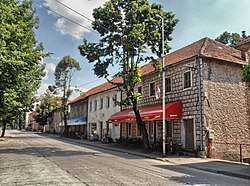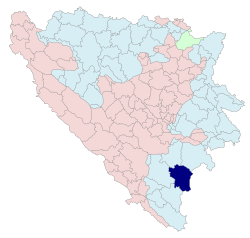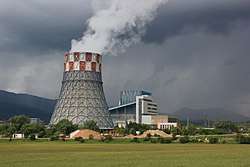Gacko
Gacko (Serbian: Гацко) is a town and municipality located in Republika Srpska, an entity of Bosnia and Herzegovina. It is situated in the region of East Herzegovina. As of 2013, the town has a population of 5,784 inhabitants, while the municipality has 8,990 inhabitants.
Gacko Гацко | |
|---|---|
Town and municipality | |
 Gacko | |
 | |
| Coordinates: 43°10′N 18°32′E | |
| Country | |
| Entity | |
| Boroughs | 71 (as of 2008) |
| Government | |
| • Mayor | Milan Radmilović (SDS) |
| • Municipality | 735.88 km2 (284.12 sq mi) |
| Population (2013 census) | |
| • Town | 5,784 |
| • Municipality | 8,990 |
| • Municipality density | 12/km2 (32/sq mi) |
| Time zone | UTC+1 (CET) |
| • Summer (DST) | UTC+2 (CEST) |
| Area code(s) | 59 |
_44.jpg)


Geography
The municipality covers an area of 736 km2 (284 sq mi), making it one of the larger municipalities in Bosnia and Herzegovina.
The town is near the state border with Montenegro.
History
Middle Ages
In the 14th century the region was governed by the powerful Vojinović family.[1]
Ottoman period
The rebels were defeated at the field of Gacko. It ultimately failed due to lack of foreign support.[3]
Modern history
Austro-Hungarian authorities took it over in 1878, a decision which was made at the Berlin Congress. In 1908, Austria-Hungary annexed Bosnia and Herzegovina sparking the Bosnian crisis which eventually led to World War I.
After that war, Gacko joined the State of Serbs, Croats and Slovenes, going on to the Kingdom of Serbs, Croats and Slovenes by the end of 1918. These were the first incarnations of Yugoslavia.
On 6 June 1941 the rebels from Gacko under command of Orthodox priest Radojica Perišić started the uprising against the genocidal Independent State of Croatia known as June 1941 uprising in eastern Herzegovina. The communist historiography intentionally ignored pre-22 June rebels in Eastern Herzegovina and Sanski Most because they occurred in the period of collaboration between communists and fascists, so it would contradict the communist narrative about rebels being led by communists.[4] On the other hand, the first Partisan battalion established in Gacko at the end of 1941 was named "6th June" in honor of the first date of the uprising.[5] In period after the Fall of the Berlin Wall Gacko municipality proclaimed 6 June as their holiday in honor of the beginning of the uprising and held public ceremonies on 6 June named as the Day of Gacko.[6]
Settlements
Aside from the town of Gacko, the municipality includes the following settlements:
- Avtovac
- Bahori
- Bašići
- Berušica
- Brajićevići
- Branilovići
- Cernica
- Čemerno
- Danići
- Dobrelji
- Domrke
- Donja Bodežišta
- Dramešina
- Dražljevo
- Drugovići
- Dubljevići
- Fojnica
- Gareva
- Gornja Bodežišta
- Gračanica
- Gradina
- Hodinići
- Igri
- Izgori
- Jabuka
- Jasenik
- Jugovići
- Kazanci
- Ključ
- Kokorina
- Kravarevo
- Kula
- Lipnik
- Lončari
- Luka
- Lukovice
- Ljeskov Dub
- Medanići
- Međuljići
- Mekavci
- Melečići
- Miholjače
- Mjedenik
- Mrđenovići
- Muhovići
- Nadinići
- Novi Dulići
- Platice
- Poda
- Pridvorica
- Pržine
- Ravni
- Rudo Polje
- Samobor
- Slivlja
- Soderi
- Srđevići
- Stambelići
- Stari Dulići
- Stepen
- Stolac
- Šipovica
- Šumići
- Ulinje
- Višnjevo
- Vratkovići
- Vrba
- Zagradci
- Zurovići
- Žanjevica
Demographics
Population
| Population of settlements – Gacko municipality | ||||||||||||||
|---|---|---|---|---|---|---|---|---|---|---|---|---|---|---|
| Settlement | 1879. | 1885. | 1895. | 1910. | 1921. | 1931. | 1948. | 1953. | 1961. | 1971. | 1981. | 1991. | 2013. | |
| Total | 9,295 | 10,582 | 12,675 | 15,107 | 13,667 | 15,235 | 14,424 | 14,628 | 13,296 | 12,033 | 10,279 | 10,788 | 8,990 | |
| 1 | Avtovac | 594 | 261 | |||||||||||
| 2 | Dobrelji | 143 | 257 | |||||||||||
| 3 | Gacko | 1,527 | 5,911 | 1,368 | 1,604 | 2,602 | 4,584 | 5,784 | ||||||
| 4 | Lipnik | 253 | 214 | |||||||||||
| 5 | Miholjače | 334 | 604 | |||||||||||
Ethnic composition
| Ethnic composition – Gacko town | |||||||
|---|---|---|---|---|---|---|---|
| 2013. | 1991. | 1981. | 1971. | ||||
| Total | 5,784 (100,0%) | 4,584 (100,0%) | 2,602 (100,0%) | 1,604 (100,0%) | |||
| Bosniaks | 2,253 (49,15%) | 1,235 (47,46%) | 776 (48,38%) | ||||
| Serbs | 2,144 (46,77%) | 1,100 (42,28%) | 776 (48,38%) | ||||
| Others | 81 (1,767%) | 10 (0,384%) | 6 (0,374%) | ||||
| Yugoslavs | 78 (1,702%) | 207 (7,955%) | 15 (0,935%) | ||||
| Croats | 28 (0,611%) | 17 (0,653%) | 10 (0,623%) | ||||
| Montenegrins | 31 (1,191%) | 20 (1,247%) | |||||
| Macedonians | 1 (0,038%) | ||||||
| Albanians | 1 (0,038%) | ||||||
| Slovenes | 1 (0,062%) | ||||||
| Ethnic composition – Gacko municipality | |||||||
|---|---|---|---|---|---|---|---|
| 2013. | 1991. | 1981. | 1971. | ||||
| Total | 8,990 (100,0%) | 10,788 (100,0%) | 10,279 (100,0%) | 12,033 (100,0%) | |||
| Serbs | 8,556 (95,17%) | 6,661 (61,74%) | 6,215 (60,46%) | 7,634 (63,44%) | |||
| Bosniaks | 369 (4,105%) | 3,858 (35,76%) | 3,424 (33,31%) | 4,184 (34,77%) | |||
| Others | 50 (0,556%) | 156 (1,446%) | 22 (0,214%) | 33 (0,274%) | |||
| Croats | 15 (0,167%) | 29 (0,269%) | 21 (0,204%) | 15 (0,125%) | |||
| Yugoslavs | 84 (0,779%) | 380 (3,697%) | 20 (0,166%) | ||||
| Montenegrins | 215 (2,092%) | 142 (1,180%) | |||||
| Macedonians | 1 (0,010%) | 3 (0,025%) | |||||
| Albanians | 1 (0,010%) | 1 (0,008%) | |||||
| Slovenes | 1 (0,008%) | ||||||
Economy

The Gacko coal mine and thermoelectric powerplant is located the municipality, and is also the largest employer in the area.
The following table gives a preview of total number of registered people employed in legal entities per their core activity (as of 2018):[7]
| Activity | Total |
|---|---|
| Agriculture, forestry and fishing | 28 |
| Mining and quarrying | 682 |
| Manufacturing | 31 |
| Electricity, gas, steam and air conditioning supply | 1,246 |
| Water supply; sewerage, waste management and remediation activities | 129 |
| Construction | 230 |
| Wholesale and retail trade, repair of motor vehicles and motorcycles | 155 |
| Transportation and storage | 78 |
| Accommodation and food services | 75 |
| Information and communication | 16 |
| Financial and insurance activities | 21 |
| Real estate activities | - |
| Professional, scientific and technical activities | 15 |
| Administrative and support service activities | 2 |
| Public administration and defense; compulsory social security | 183 |
| Education | 185 |
| Human health and social work activities | 79 |
| Arts, entertainment and recreation | 39 |
| Other service activities | 36 |
| Total | 3,230 |
Sport
The local football club, FK Mladost Gacko, plays in the First League of the Republika Srpska.
Notable people
- Edin Džeko, footballer
- Admir Ćatović, footballer
- Nemanja Supić, footballer
- Saša Starović, volleyball player
- Sanja Starović, volleyball player
- Vukašin Višnjevac, football coach
- Dušan Bajević, footballer and football coach
- Vule Avdalović, basketball player
- Nemanja Gordić, basketball player
See also
References
- Fine, John Van Antwerp, Jr. (1994). The Late Medieval Balkans: A Critical Survey from the Late Twelfth Century to the Ottoman Conquest. University of Michigan Press. p. 53. ISBN 978-0-472-08260-5.
- SANU (1908). Glas. 78–80. SANU. p. 196.
- Ćorović, Vladimir (2001) [1997]. "Преокрет у држању Срба". Историја српског народа (in Serbian). Belgrade: Јанус.CS1 maint: ref=harv (link)
- Mandić, Petar. "Prva puška hercegovačka". Novosti. Večernje Novosti. Retrieved 28 April 2020.
- Književnost. Prosveta. 2004. p. 7.
Да је овај Устанак почео 6. а не 7. јуна, зна се и по томе што се први партизански батаљон, који је настао у Гацку крајем 1941. године, звао Батаљон 6. јун
- Crnogorac, Svetozar. "DAN ZA ISTORIJU - 6. JUN 1941: Hercegovci započeli prvi ustanak u porobljenoj Evropi". Herceg TV. Herceg TV. Retrieved 28 April 2020.
- "Cities and Municipalities of Republika Srpska" (PDF). rzs.rs.ba. Republika Srspka Institute of Statistics. 25 December 2019. Retrieved 31 December 2019.
Bibliography
- Bataković, Dušan T. (1996). The Serbs of Bosnia & Herzegovina: History and Politics. Dialogue Association.CS1 maint: ref=harv (link)
- HadžiMuhamedović, Safet (2018) Waiting for Elijah: Time and Encounter in a Bosnian Landscape. New York and Oxford: Berghahn Books.